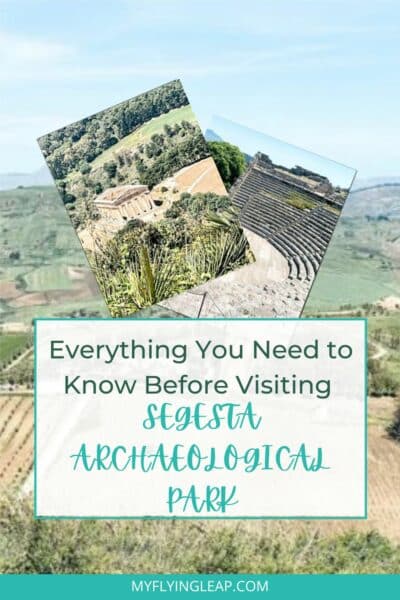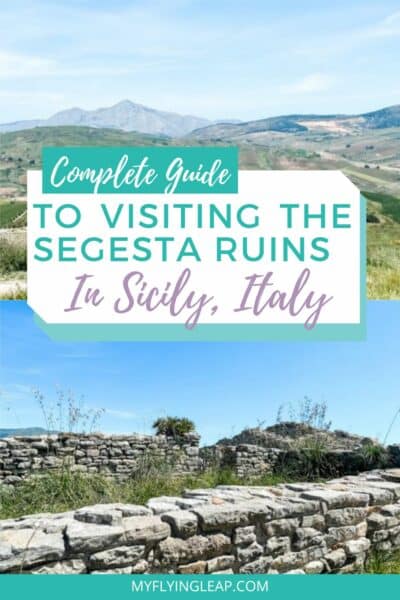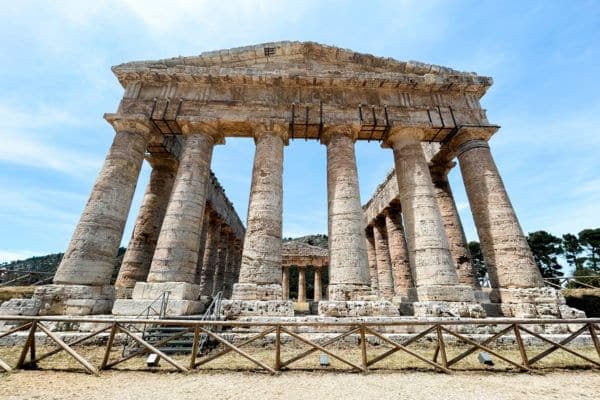Segesta Archaeological Park—All You Need to Visit the Segesta Ruins in Sicily
Visiting Segesta Archaeological Park is one of the top day trips from Palermo and an unmissable thing to do when visiting Sicily.
Sicily is a treasure trove of many incredible sites hailing back to ancient Greek and Roman times. Perched near the top of a mountain overlooking a grassy, hilly area is Segesta Archaeological Park.
It’s so interesting to visit as it seems to be in the middle of fields with no hints that there was once a great city in the area until you came upon it. Segesta is in the middle of a gorgeous hilly landscape with a patchwork of greens, trees, and farms.
My obsession with history, architecture, and “old, crumbly buildings” led me to Segesta early on in my two-week trip exploring western Sicily. Even after two weeks in this incredible area, it’s still one of the highlights of the adventure.
Here’s what you’ll see at Segesta Archaeological Park and everything you need to know to visit.
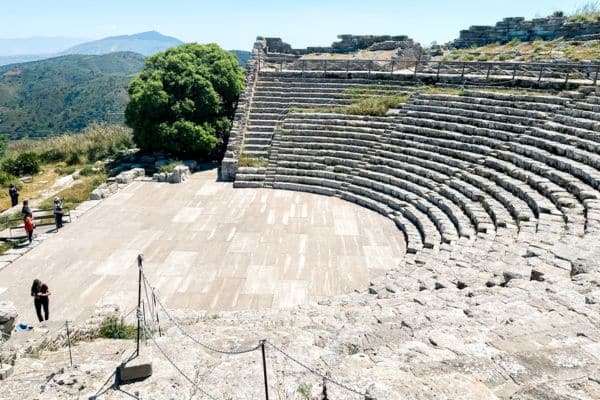
This post may contain affiliate links, which means I’ll receive a commission if you purchase through my links at no extra cost to you. Please read the full disclosure for more information.
Brief History of Segesta
Segesta is an ancient city that was built on the top of Barbaro Mountain. It was established around 800 BC, given the advantageous location. The site was defended by steep rock walls in the south and the east, providing some defense from invaders.
The site had a north and south acropolis located strategically on two summits. It was populated by the Elymians, people of unknown origin. Some believe they were one of the native Sicilian indigenous groups, and others believe they may have hailed from Troy, Greece.
The city grew substantially between the second and first century BC due to Greek and Phoenician influences. Segesta reached its peak of wealth and power in the 5th century BC, after the first Punic War.
Segesta had troubled relations with nearby Selunente and eventually conquered them. This wasn’t the end of the story, though. The city was caught between international battles between Greek and Carthage.
Berbers from Africa arrived later, and in the 12th century, it was conquered by the Normans.
People were forced to convert to Christianity during this bloody war. When it was over, people were deported, and the site was abandoned.
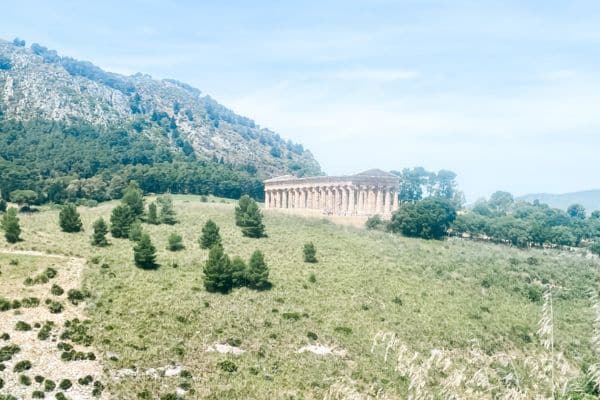
What to See at Segesta Archaeological Park (Parco Archeologico di Segesta)
There are two highlights of visiting Segesta: the temple and the theater. Both have been partially rebuilt, so you get impressive views of these structures.
If you do nothing else, make sure you visit both. But there are other places to visit on this site that are interesting and require a little imagination.
If you get the audioguide, you’ll learn more about them. And they are worth visiting when you go.
Segesta Temple (Il Tempio or Tempio di Segesta)
One of the two highlights of a visit to Segesta, the temple, will likely be your first stop. It’s close to the ticket building and just a short walk up a hill to get there. It’s the lone structure on this hill west of the town of Segesta.
There are some trees along the way to the Segesta Temple for shade if you go on a hot day. Take your time to enjoy the views of the temple as you arrive.
This Doric temple in the Greek Sicilian style was constructed in 430 BC and dedicated to Aphrodite Uranea. It was built with six columns on the front and back of the temple and 14 on each side.
However, it was never finished. Construction halted during the war between Segesta and Selinunte.
It was later abandoned around 20 years later when Carthage captured the city.
If it looks familiar, it should if you’re doing any research on Sicily. This temple is often depicted as a representation of Sicily, and you’ll see it on a lot of sites and marketing materials about the island.
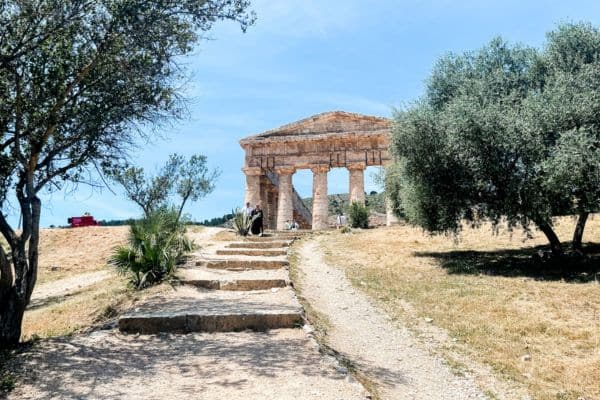
Theater (il Teatro)
Another prime spot to see at Segesta Archaeological Park is the amphitheater. This is a bit more of a distance from the visitor area, so it’s worth getting a ticket for the Segesta bus on hot days.
Otherwise, go for a stroll along the road to visit. You’ll get some incredible views along the way of the area around and the temple from above. It’s perched atop Mount Babaro, the highest peak in the area.
This massive ringed dome was built to hold around four thousand people. It was built around the second century BC. There were two stages of construction, including the stage and then the orchestra.
Spectators were separated into two sections based on their wealth and status. It was enlarged by the Romans.
The theater was excavated in the early 18th century. At that time, it was found that it rested on the mountain slope and was erected on the remains of a native village. You can see the floor of an ancient hut below the stage today.

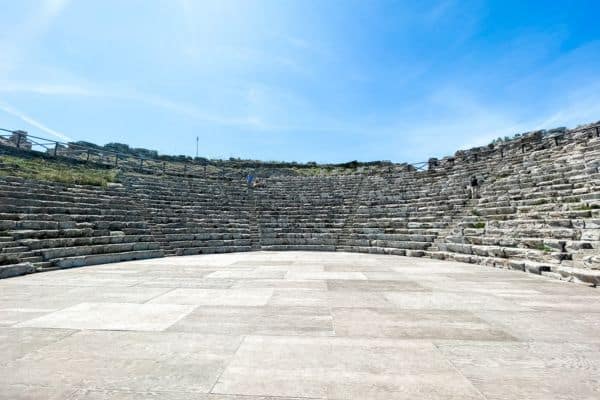
In the distance, you can see La Casa del Navarca. It was once a home that belonged to Navarca Eraclio, a friend of Cicero.
It was discovered fairly recently, and the mosaics and structure of the home show similarities to the House of the Griffin (Casa dei Grifi) in Palatine Hill in Rome.
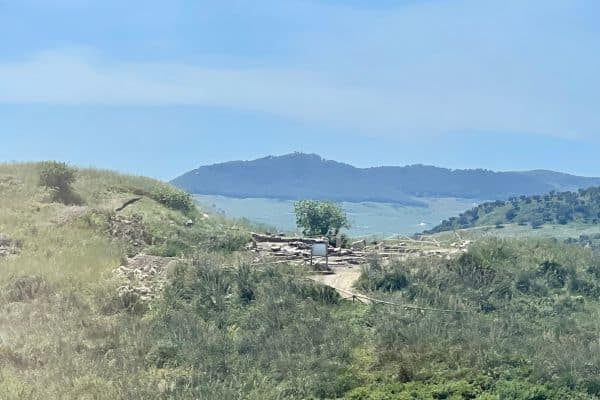
Castle
The Castle of Calata Barbaro was built around the 12th century by the Normans. It’s strategically positioned at the top of one of the hills.
Renovations were made in the first half of the 13th century; it was later abandoned.
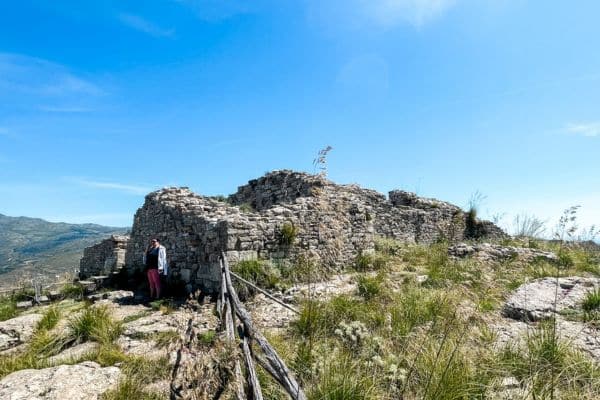
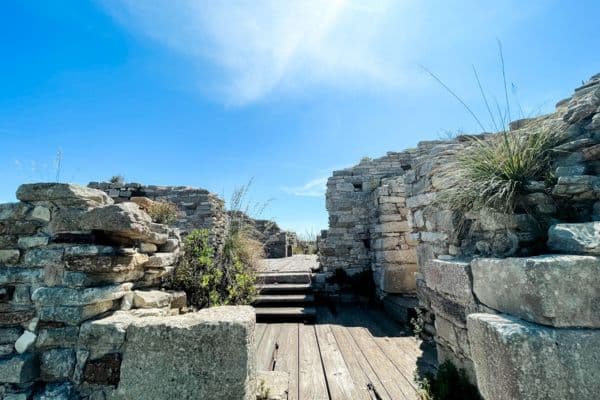
Other Areas
There are several other spots with ruins worth visiting in the park. These have either not been reconstructed or were much less so, leaving it more to your imagination when you visit.
There are several structures near the castle, including a mosque, a church, and more. Wander through this area and read the signs to learn more about the function these structures served.
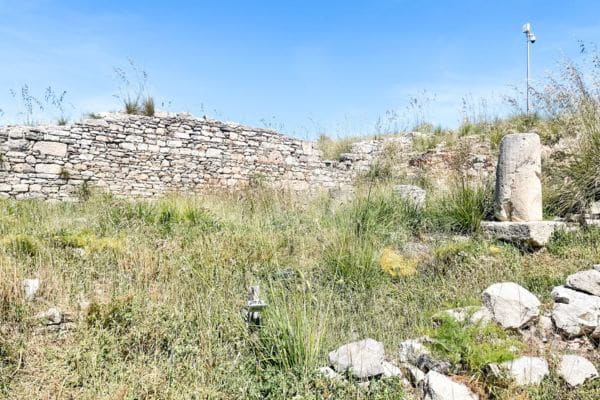
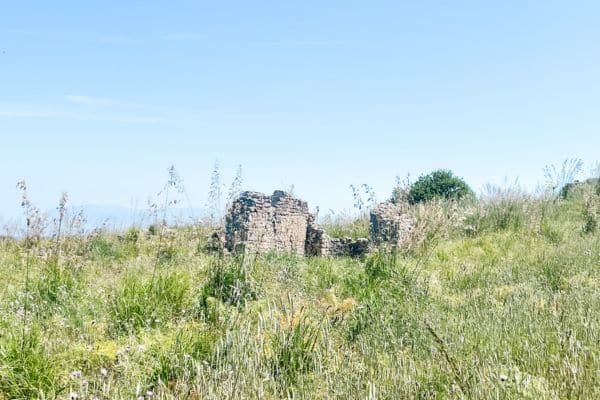
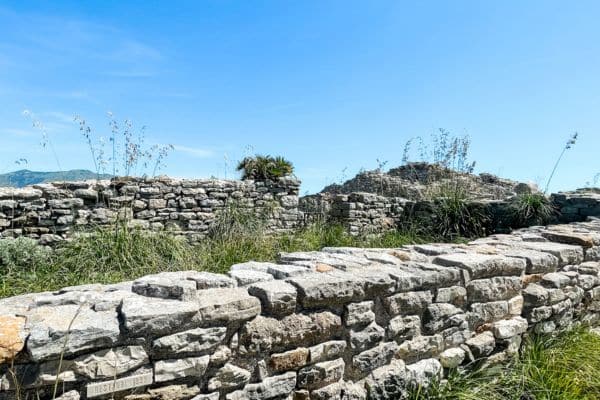
Cave Dwellings
On some of the steep hill slopes, you’ll find terraces and hollow primitive dwellings used off and on in this area for centuries. They were believed to have been first created in the 6th century BC.
Though rustic, some tile floors were found and even frescoes on the walls. After a fire in the first century BC, they were abandoned and used as a trash dump.
Museum of Segesta
The Museum at the park was recently restored. It was unfortunately closed when I visited, so I was unable to see the treasures inside.
You’ll find artifacts from the main sacred areas: the Great Temple, the Acropolis, and the Sanctuary. Large panels provide the history of this once-thriving city.
Artifacts include ceramics and bronze made locally and in Greece.
Segesta Archaeological Park Visit Details
There are several ticket options for visiting the Segesta ruins. There is a small ticket office next to the parking lot, where you purchase the tickets to visit.
- Segesta Archaeological Park is located at Contrada Barbaro, SR 22, 91013 Calatafimi TP, Italy.
- The entrance fee for visiting the park and nearby Pianto Romano is 8 Euros (around $8.75 USD)
- The Segesta bus costs 2 Euros (around $2.25 USD). It picks up on the road next to the ticket office.
- The audioguide costs 5 Euros, (around $5.50 USD). If you don’t take a tour, it’s worth getting. You will leave your license when you get it and will get it back upon return.
- The park is open from 9 to 5 from January 1 to February 28. Then, through March 26th, it’s open until 6:30 p.m., from March 27 to September 30 until 7:30 p.m., in October until 6:30 p.m., and until 5 p.m. from October 30 through the end of the year. The last entry is 1.5 hours before closing.
- You’ll find a small cafe with a shop and bathrooms near the ticket office. You can grab food, drinks, and souvenirs here. There are picnic tables where you can eat your purchased food or bring your own. A nice big tree beside the tables offers some lovely shade on hot days.
You can send a postcard from the small on-site post office if you’re interested!
Get started by walking up the path from the facilities to the temple. Once you see a glimpse of it, it’ll undoubtedly be the first spot you visit.
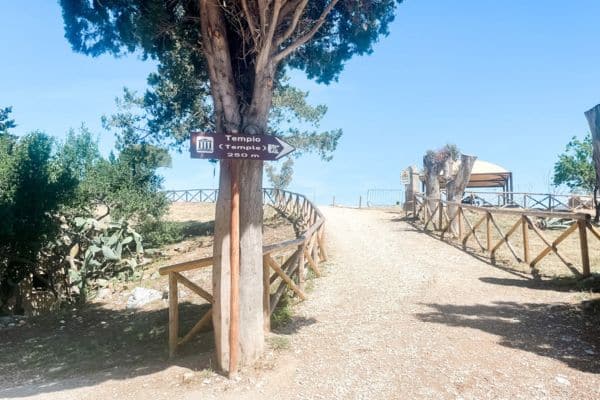
When to Visit Segesta Archaeological Park
Visiting Segesta is a great activity at any time, as the park is open year-round. Keep in mind that you’ll be outside with no cover, so plan accordingly based on the weather.
May and June are lovely for the wildflowers, and May is still considered off-season, so you’ll find fewer crowds. The summer is lush and green in the meadows around the site, but it will be busy with tourists and summer travelers.
Winter is chilly, but you’ll find fewer crowds. It’s a great time to visit to do some hiking around the different areas of the park.
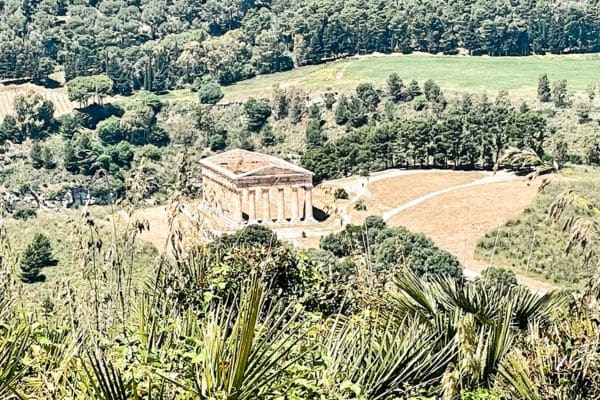
How Much Time to Spend in Segesta Archaeological Park
You’ll want to spend between two and four hours at Segesta, and perhaps more if you want to do some hiking and don’t use the shuttle bus.
If you take the bus, you can see most of the main sites in a couple of hours. However, it is a bit spread out, which doesn’t leave much time to explore and take it all in.
Three to four hours is probably best for those who listen to the audioguide, want to spend some time at each site, and want to do some walking and hiking.
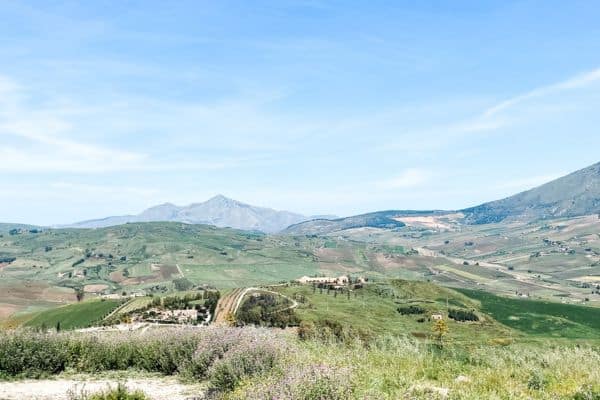
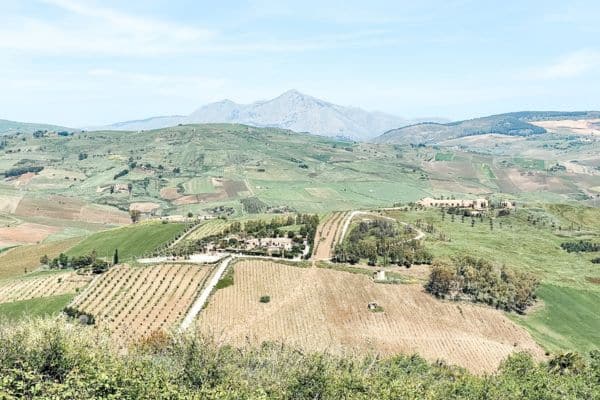
How to Get to Segesta Archaeological Park
The easiest way to visit Segesta is with a tour, with options from Palermo and Trapani.
Driving to Segesta
If you’re up for a challenge, consider driving there so you can take as much time as you want.
From Palermo, you’ll drive on the A29 motorway towards Trapani. Exit at Segesta, and head to Calatafimi Segesta following signs to the archaeological park. (If you’re driving from Trapani, head towards Palermo and follow the same directions.)
You’ll follow the same route from Castellammare del Golfo, where I stayed when visiting. It’s only around 20 km from there (around 12.5 miles), so it’s an easy drive.
Getting there is fairly easy, especially with Google Maps. Definitely rely on navigation when you visit.
You probably won’t want to rely on signs, as it would be tough going. No highway numbers are listed on signs in much of Sicily, and no exit numbers. All you’ll see are signs with small writing with cities/towns listed. They are often in large groups, so you could easily miss them.
You’ll meander on narrow and very winding roads to get there. There’s nowhere to pull off to check navigation or to take pictures, so enjoy the views. You’ll see lots of farms in the area.
When you get close, you’ll see the large temple on top of a hill in the middle of nowhere. Farms and vineyards surround it.
Park in the lot and head to the ticket center on the edge of it to pay your entrance fee.
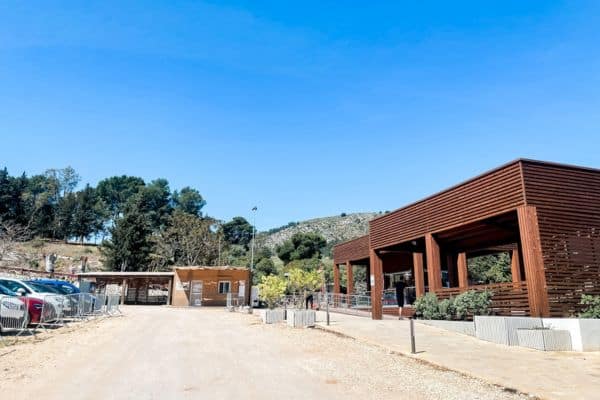
How to Get Around Segesta Archaeological Park
The best way to get around the park is by foot. However, some of the sites are at a distance from each other. So, if you’re not up for that much walking or it’s a hot day, there is a shuttle bus.
Even with the Segesta bus, there is a good bit of walking on uneven terrain. It runs every 15 to 20 minutes, generally when it fills up. Remember that even with the bus, you’ll have a good bit of walking between the various sites.
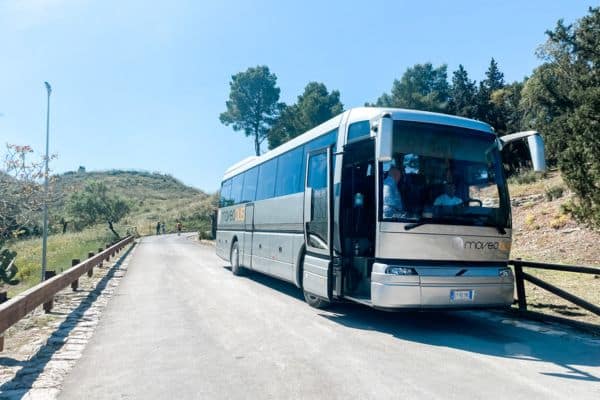
What to Do Around Segesta
Though Segesta Archaeological Park is the highlight of this area, another popular thing to do is visit the Segesta thermal baths (Terme di Segesta).
You have two options for visiting: a paid thermal spa and a free one. The paid one is at Terme Segestane Spa. It’s well-maintained and offers spa services as well as a thermal bath.
The free hot springs area is not far behind it, a “local secret.” They are lovely. However, they are not well-maintained. You’ll often find trash around the area, so it’s not always the best experience.
There is a small parking lot nearby, and you will need a car to get to either place.
When Will You Visit Segesta, Sicily?
Segesta is a fascinating historical site that makes a perfect half-day trip from Palermo, Castellammare del Golfo, or Trapani. Though it’s interesting to visit, comparing the site with other archaeological sites of Selinunte and the Valley of the Temples is even more fascinating.
Together, these provide a backdrop for Sicily’s complex and changing history.
You Might Also Like
- What to Expect at Gypset Yoga Retreat Italy—a Detailed Review
- 11 of the Best Things to do in Capri for a Perfect Day
- What to See When You Visit Pompeii Archaeological Park
- Why You Should Visit the Herculaneum Ruins + Top Tips
- Rome in a Weekend—How to See All of the Top Sites
- 3 Best Umbria Towns to Visit—Gubbio, Perugia, and Assissi, Italy
- Visit the Vatican—A How to Guide for Visiting Vatican City
- Naples National Archaeological Museum—Why It’s a Must-See + Visit Tips
- Trastevere in Rome—What to See + Top Trastevere Restaurants
- Top Things to Do in Sorrento & Reasons to Stay There
- Selinunte Archaeological Park—Visit the Selinunte Greek Ruins in Sicily
- Marsala Salt Pans—Why You Should Visit & What to Expect
- 8 Top Things to Do in Cefalù in One Day
Like it? Pin it!

